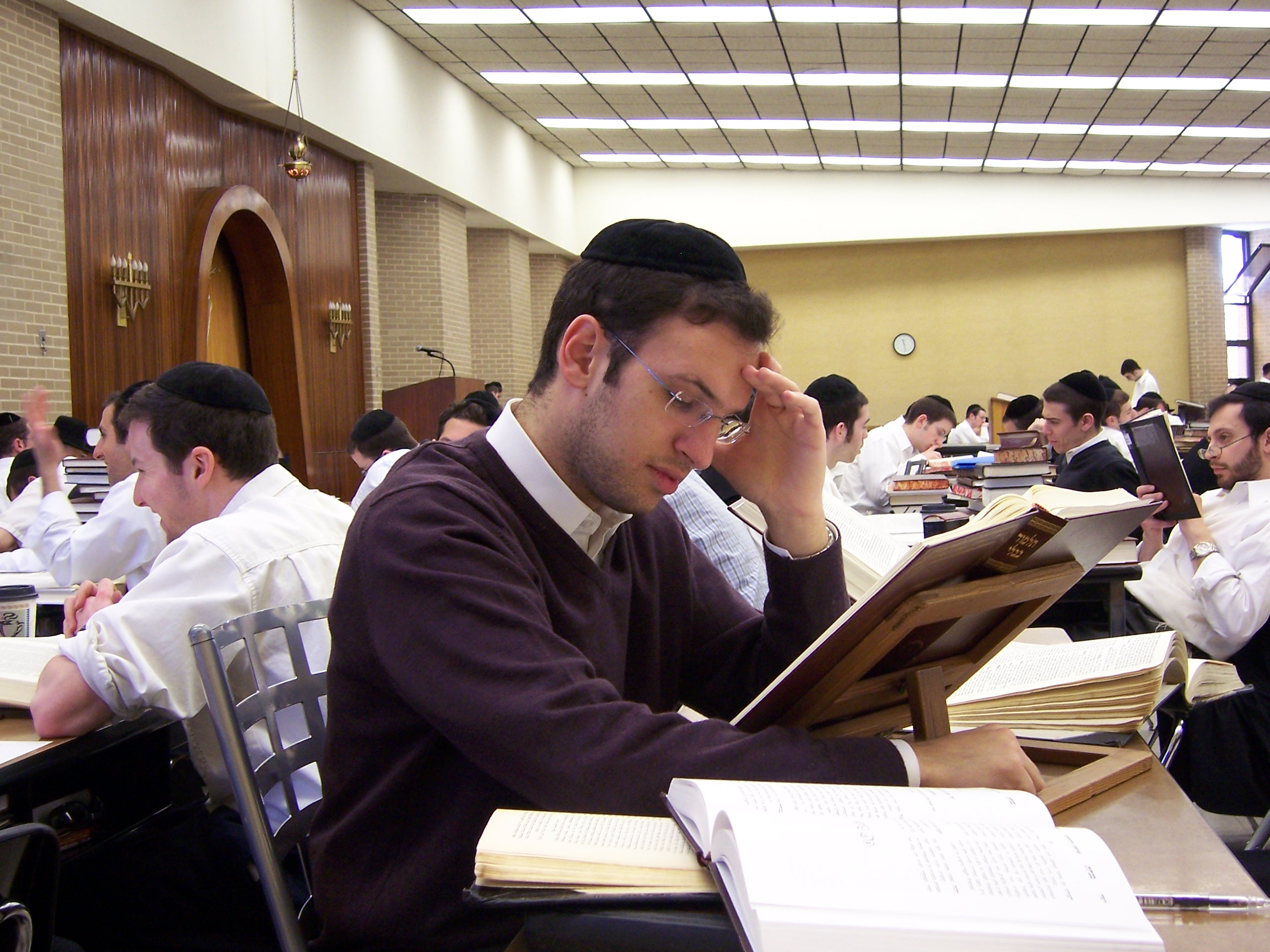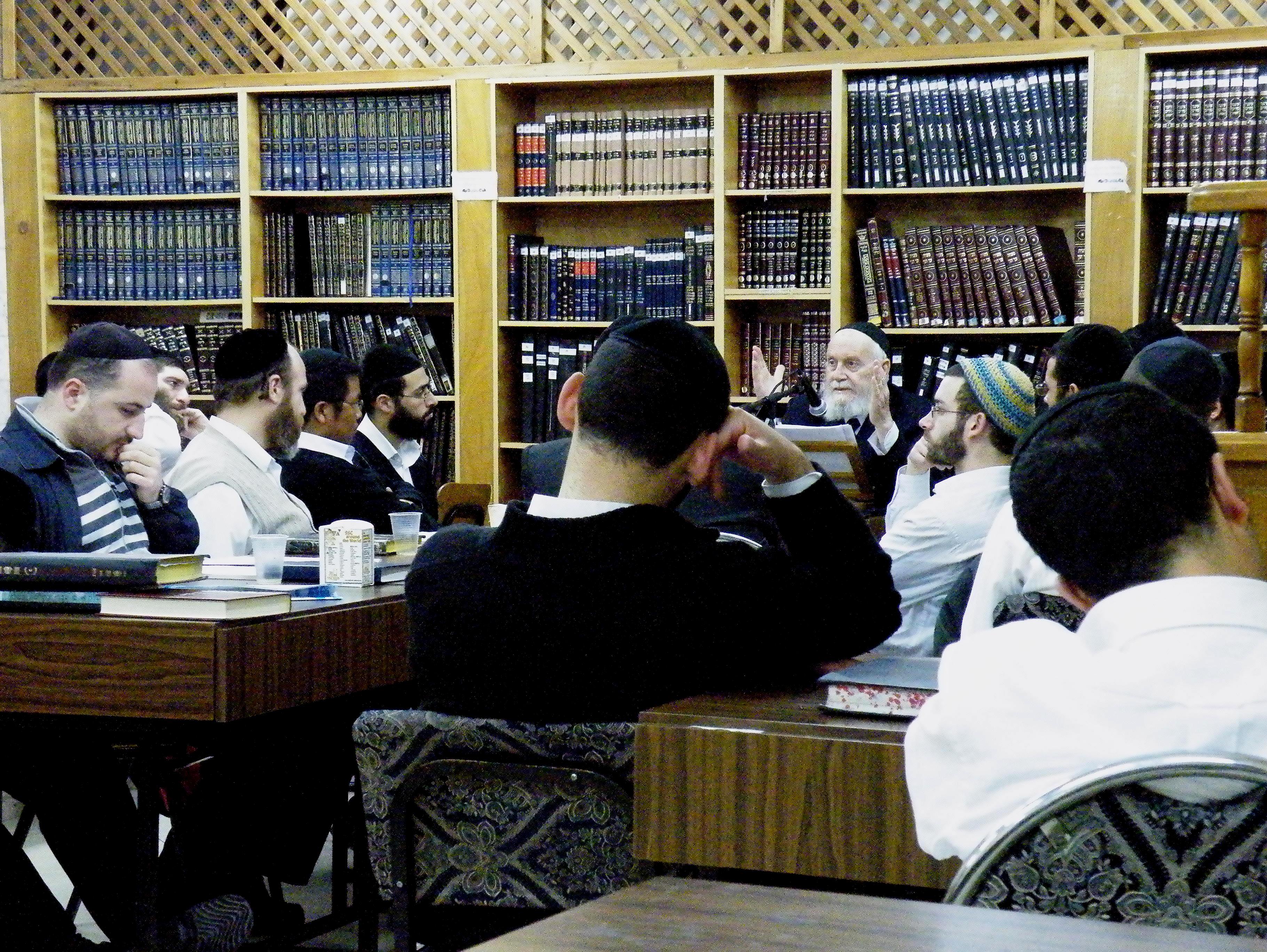|
Beit Midrash
A ''beth midrash'' (, "house of learning"; : ''batei midrash''), also ''beis medrash'' or ''beit midrash'', is a hall dedicated for Torah study, often translated as a "study hall". It is distinct from a synagogue (''beth knesseth''), although the two are often coextensive. In Yiddish the ''beth midrash'' may be referred to as a ''zal'', i.e. "hall". ''Beis midrash'' can also refer to a yeshiva gedolah, the undergraduate-level program in Orthodoxy, for boys over 12th grade. The Arabic term "madrasah" is derived from the same Semitic root, and refers to any type of educational institution. The root דרש means "to seek nowledge and is then generalized to mean "expound". History Early rabbinic literature, including the Mishnah, makes mention of the ''beth midrash'' as an institution distinct from the '' beth din'' and Sanhedrin. It was meant as a place of Torah study and interpretation, as well as the development of ''halakha'' (the practical application of the Jewish Law). ... [...More Info...] [...Related Items...] OR: [Wikipedia] [Google] [Baidu] |
Second Temple
The Second Temple () was the Temple in Jerusalem that replaced Solomon's Temple, which was destroyed during the Siege of Jerusalem (587 BC), Babylonian siege of Jerusalem in 587 BCE. It was constructed around 516 BCE and later enhanced by Herod the Great around 18 BCE, consequently also being known as Herod's Temple thereafter. Defining the Second Temple period and standing as a pivotal symbol of Jewish identity, it was the basis and namesake of Second Temple Judaism. The Second Temple served as the chief place of worship, ritual sacrifice (''korban''), and communal gathering for the Jewish people, among whom it regularly attracted pilgrims for the Three Pilgrimage Festivals: Passover, Shavuot, and Sukkot. In 539 BCE, the Fall of Babylon, Persian conquest of Babylon enabled the Achaemenid Empire to expand across the Fertile Crescent by annexing the Neo-Babylonian Empire, including the territory of the former Kingdom of Judah, which had been annexed as the Yehud (Babylonian provi ... [...More Info...] [...Related Items...] OR: [Wikipedia] [Google] [Baidu] |
Mishneh Torah
The ''Mishneh Torah'' (), also known as ''Sefer Yad ha-Hazaka'' (), is a code of Rabbinic Jewish religious law (''halakha'') authored by Maimonides (Rabbi Moshe ben Maimon/Rambam). The ''Mishneh Torah'' was compiled between 1170 and 1180 CE (4930 and 4940 AM), while Maimonides was living in Egypt, and is regarded as Maimonides' '' magnum opus''. Accordingly, later sources simply refer to the work as "''Maimon''", "''Maimonides''", or "''RaMBaM''", although Maimonides composed other works. ''Mishneh Torah'' consists of fourteen books, subdivided into sections, chapters, and paragraphs. It is the only medieval-era work that details all of Jewish observance, including those laws that are only applicable when the Temple in Jerusalem is in existence, and remains an important work in Judaism. Its title is an appellation originally used for the Biblical book of Deuteronomy, and its moniker, "Book of the Strong Hand", derives from its subdivision into fourteen books: the numerical v ... [...More Info...] [...Related Items...] OR: [Wikipedia] [Google] [Baidu] |
Shulchan Aruch
The ''Shulhan Arukh'' ( ),, often called "the Code of Jewish Law", is the most widely consulted of the various legal codes in Rabbinic Judaism. It was authored in the city of Safed in what is now Israel by Joseph Karo in 1563 and published in Venice two years later. Together with its commentaries, it is the most widely accepted compilation of halakha or Jewish law ever written. The halachic rulings in the ''Shulhan Arukh'' generally follow Sephardic law and customs, whereas Ashkenazi Jews generally follow the halachic rulings of Moses Isserles, whose glosses to the ''Shulhan Aruch'' note where the Sephardic and Ashkenazi customs differ. These glosses are widely referred to as the ''mappā'' "tablecloth" to the "Set Table". Almost all published editions of the ''Shulchan Aruch'' include this gloss, and the term has come to denote both Karo's work as well as Isserles', with Karo usually referred to as "the ''Meḥabbēr''" (, "Author") and Isserles as "the Rema" (a Hebrew acr ... [...More Info...] [...Related Items...] OR: [Wikipedia] [Google] [Baidu] |
Siddur
A siddur ( ''sīddūr'', ; plural siddurim ) is a Jewish prayer book containing a set order of daily prayers. The word comes from the Hebrew root , meaning 'order.' Other terms for prayer books are ''tefillot'' () among Sephardi Jews, ''tefillah'' among German Jews, and ''tiklāl'' () among Yemenite Jews. History The earliest parts of Jewish prayer books are the '' Shema Yisrael'' ("Hear O Israel") (Deuteronomy 6:4 ''et seq'') and the Priestly Blessing ( Numbers 6:24-26), which are in the Torah. A set of eighteen (currently nineteen) blessings called the ''Shemoneh Esreh'' or the ''Amidah'' (Hebrew, "standing rayer), is traditionally ascribed to the Great Assembly in the time of Ezra, at the end of the biblical period. The name ''Shemoneh Esreh'', literally "eighteen", is a historical anachronism, since it now contains nineteen blessings. It was only near the end of the Second Temple period that the eighteen prayers of the weekday Amidah became standardized. Even at ... [...More Info...] [...Related Items...] OR: [Wikipedia] [Google] [Baidu] |
Tanach
The Hebrew Bible or Tanakh (;"Tanach" . ''''. ; ; or ), also known in Hebrew as (; ), is the canonical collection of scriptures, comprising the (the five Books of Moses), the |
Torah
The Torah ( , "Instruction", "Teaching" or "Law") is the compilation of the first five books of the Hebrew Bible, namely the books of Genesis, Exodus, Leviticus, Numbers and Deuteronomy. The Torah is also known as the Pentateuch () or the Five Books of Moses. In Rabbinical Jewish tradition it is also known as the Written Torah (, ). If meant for liturgic purposes, it takes the form of a Torah scroll ( '' Sefer Torah''). If in bound book form, it is called '' Chumash'', and is usually printed with the rabbinic commentaries (). In rabbinic literature, the word ''Torah'' denotes both the five books ( "Torah that is written") and the Oral Torah (, "Torah that is spoken"). It has also been used, however, to designate the entire Hebrew Bible. The Oral Torah consists of interpretations and amplifications which according to rabbinic tradition have been handed down from generation to generation and are now embodied in the Talmud and Midrash. Rabbinic tradition's underst ... [...More Info...] [...Related Items...] OR: [Wikipedia] [Google] [Baidu] |
Talmud
The Talmud (; ) is the central text of Rabbinic Judaism and the primary source of Jewish religious law (''halakha'') and Jewish theology. Until the advent of Haskalah#Effects, modernity, in nearly all Jewish communities, the Talmud was the centerpiece of Jewish culture, Jewish cultural life and was foundational to "all Jewish thought and aspirations", serving also as "the guide for the daily life" of Jews. The Talmud includes the teachings and opinions of thousands of rabbis on a variety of subjects, including halakha, Jewish ethics, Jewish philosophy, philosophy, Jewish customs, customs, Jewish history, history, and Jewish folklore, folklore, and many other topics. The Talmud is a commentary on the Mishnah. This text is made up of 63 Masekhet, tractates, each covering one subject area. The language of the Talmud is Jewish Babylonian Aramaic. Talmudic tradition emerged and was compiled between the destruction of the Second Temple in 70 CE and the Arab conquest in the early seve ... [...More Info...] [...Related Items...] OR: [Wikipedia] [Google] [Baidu] |
Lectern
A lectern is a standing reading desk with a slanted top, on which documents or books are placed as support for reading aloud, as in a scripture reading, lecture, or sermon. A lectern is usually attached to a stand or affixed to some other form of support. To facilitate eye contact and improve posture when facing an audience, lecterns may have adjustable height and slant. People reading from a lectern, called lectors, generally do so while standing. The word has its origins in the medieval Latin term ''lectrum'', related to ''legere'' which means 'to read'. In pre-modern usage, the word ''lectern'' was used to refer specifically to the "reading desk or stand ... from which the Scripture lessons (''lectiones'') ... are chanted or read." One 1905 dictionary states that "the term is properly applied only to the class mentioned [church book stands] as independent of the pulpit." By the 1920s, however, the term was being used in a broader sense; for example, in reference to a memorial se ... [...More Info...] [...Related Items...] OR: [Wikipedia] [Google] [Baidu] |
Yeshiva
A yeshiva (; ; pl. , or ) is a traditional Jewish educational institution focused on the study of Rabbinic literature, primarily the Talmud and halacha (Jewish law), while Torah and Jewish philosophy are studied in parallel. The studying is usually done through daily '' shiurim'' (lectures or classes) as well as in study pairs called '' chavrusas'' ( Aramaic for 'friendship' or 'companionship'). '' Chavrusa''-style learning is one of the unique features of the yeshiva. In the United States and Israel, different levels of yeshiva education have different names. In the U.S., elementary-school students enroll in a '' cheder'', post- bar mitzvah-age students learn in a '' mesivta'', and undergraduate-level students learn in a '' beit midrash'' or '' yeshiva gedola'' (). In Israel, elementary-school students enroll in a Talmud Torah or '' cheder'', post-bar mitzvah-age students learn in a ''yeshiva ketana'' (), and high-school-age students learn in a ''yeshiva gedola''. ... [...More Info...] [...Related Items...] OR: [Wikipedia] [Google] [Baidu] |
Shiur Klali In Yeshivas Kerem B'Yavne
A shiur (, , ; , ) is a lecture given any Torah-related topic of study, such as Gemara, Mishnah, ''Halakha'' (Jewish law), or Tanakh (Hebrew Bible), usually given in a yeshiva, though commonly in other Jewish communal settings. History The Hebrew term שיעור ("designated amount") came to refer to a portion of Judaic text arranged for study on a particular occasion, such as a yahrzeit, the dedication of a new home, or the evening of a holiday, and then to a public reading and explanation of the same. The act of teaching and studying these texts at the designated time was known as ''shiur lernen'' (); by synecdoche, the act itself became known as ''shiur''. These shiurim would be attended by all classes of people; it was traditional for learned attendees to engage the lecturer in continuous discussion, and for the larger lay audience to listen intently. Concurrently, in the yeshiva-setting it came to refer to the daily study quotient for students, and then to the le ... [...More Info...] [...Related Items...] OR: [Wikipedia] [Google] [Baidu] |
Houses Of Hillel And Shammai
The House of Hillel (Beit Hillel) and House of Shammai (Beit Shammai) were, among Jewish scholars, two schools of thought during the period of tannaim, named after the sages Hillel and Shammai (of the last century BCE and the early 1st century CE) who founded them. These two schools had vigorous debates on matters of ritual practice, ethics, and theology which were critical for the shaping of the Oral Law and Judaism as it is today. The Mishnah mentions the disagreement of Hillel and Shammai as one which had lasting positive value: In most cases, though not always, Beit Hillel's opinion is the more lenient and tolerant of the two. In nearly all cases, Beit Hillel's opinion has been accepted as normative by halacha, and is the opinion followed by modern Jews. Halachic disputes Examples Only three (or, according to some authorities, five) disputes are recorded between Hillel and Shammai themselves. However, with time the differences between their respective schools multipli ... [...More Info...] [...Related Items...] OR: [Wikipedia] [Google] [Baidu] |







